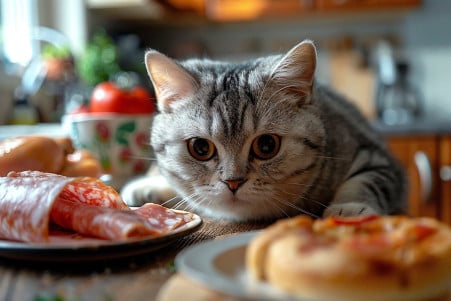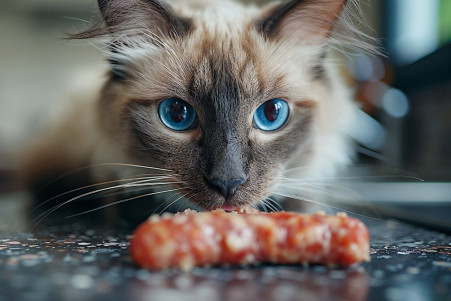Can Cats Eat Bologna? Understanding Feline Dietary Risks
19 March 2024 • Updated 17 March 2024

Bologna is a lunchtime staple, but can you give some to your cat? Because it’s high in salt and fat and contains potentially harmful additives like garlic and nitrates, you should not give bologna to your cat. While small amounts on rare occasions may not have immediate negative effects, regular consumption can cause problems such as obesity and sodium ion poisoning.
This article will take a deep dive into the nuances of cat nutrition and explore the risks of processed meats like bologna. By combining information from veterinary professionals, nutritional studies, and recommendations from reputable pet organizations, we will offer a thorough look at what makes up a healthy and safe diet for your cat. This knowledge will help you feel confident in the choices you make for your pet’s diet and health.
Can cats eat bologna?
Knowing Your Cat’s Nutritional Requirements
Cats are obligate carnivores, which means they have to get their nutritional requirements from animal-based proteins. According to the Cornell University College of Veterinary Medicine, animal-based proteins are the only source of essential amino acids and fatty acids for cats, and these can’t be replaced by plant-based nutrients. Their evolution as a species has led to a diet that is high in protein, moderate in fat, and low in carbohydrates.
According to VCA Animal Hospitals, the essential nutrients that cats need, like taurine and arginine, are primarily found in animal tissue, and they are essential for maintaining cellular health. If cats don’t get enough of these nutrients, it can lead to a number of health problems.
In addition, according to the Countryside Veterinary Clinic, cats’ nutritional needs change as they age. For example, kittens need more fat and protein to support their rapid growth, while senior cats may need changes in minerals to support their aging systems.
In general, feeding cats human food like bologna can be dangerous because it doesn’t meet their nutritional needs and may contain harmful ingredients. However, when it comes to why bologna is bad for cats, it’s not just the general nutritional imbalance that’s a problem, but also the individual additives and how they can affect cats.
Harmful Ingredients in Bologna
Bologna is not a cat-friendly treat, and this is largely due to the ingredients that can be harmful to cats. Nitrates, which are used as preservatives in processed meats like bologna, are especially problematic. Nitrates have been linked to the development of methemoglobinemia, a condition that decreases the blood’s ability to carry oxygen and can be deadly to cats.
Spices, like garlic, are also poisonous to cats and can cause issues like gastrointestinal upset and damage to red blood cells.
According to PetMD, cats need 11 essential amino acids in their diet, and these are typically found in meat. Bologna may be deficient in these essential amino acids or have them in imbalanced ratios, leading to nutritional imbalances. In addition, the high sodium content in bologna, as highlighted by PetMD, can cause high blood pressure and contribute to issues like heart disease and kidney problems in cats.
Moreover, bologna is made with low-quality proteins and preservatives that not only meet the nutritional needs of cats but also introduce ingredients that could cause long-term health problems. This underscores the importance of cat owners understanding that while certain human foods may not seem dangerous, they can be harmful to their pets, and it also raises the question of the importance of protein in a cat’s diet.
Protein’s Importance in a Cat’s Diet
Cats require a diet that’s high in protein, and it’s important for their overall health and well-being. Protein provides energy and helps with important bodily processes like healing and the immune system. While bologna is a processed meat that can have different levels of protein, cats will benefit from lean meats like chicken or turkey, which offer a higher quality protein that’s more in line with what they would eat in the wild.
A study in PMC found that cats are able to digest animal protein very well, which allows them to get the amino acids they need from their diet. On the other hand, a diet high in fat and carbohydrates, like bologna, can lead to obesity and other health issues in cats.
To ensure your cat’s diet is as healthy as possible, make sure you’re choosing protein sources that are high quality. Look for meats that are low in additives and high in important nutrients that will help keep your cat healthy and strong, and avoid processed meats like bologna.
Sodium and Preservative Effects on Cats
While cats require sodium in their diet, it should be consumed in limited amounts. The National Research Council has set the safe upper limit for sodium at 740 mg per megajoule (mg/mJ) of metabolizable energy. A study published in PubMed states that this amount is safe for cats. However, going over this limit can result in issues such as sodium ion poisoning, which can cause symptoms like vomiting, diarrhea, and seizures.
The preservatives in bologna, particularly sodium nitrate, can be toxic to cats. As the EveryCat Health Foundation explains, while high sodium intake is often linked to hypertension and other cardiovascular issues in people, these links don’t necessarily apply to cats. As PetMD notes, long-term studies have shown that even senior cats fed a high-sodium diet didn’t have any negative impacts on their kidney function or blood pressure after two years.
While cats appear to be able to tolerate high levels of sodium, it’s important to monitor and control their intake to avoid potential problems. This includes not feeding them high-sodium foods like bologna and instead feeding them fresh meats that don’t contain added salts or preservatives. By being careful about what you feed your cat, you can make sure they get the nutrients they need in a way that’s safe and healthy.
Healthy and Safe Meat Options for Your Cat
If you want to make sure you’re feeding your cat the right diet, it’s important to make sure the meat you’re feeding them is both nutritious and safe. Lean proteins, such as turkey, chicken, and beef, are all great options to bologna and other processed meats. These proteins will give your cat the high-quality protein they need without the added salt, fat, and harmful preservatives that processed meats have, according to Litter-Robot.
When you’re introducing new foods to your cat, make sure to start with small amounts and monitor for any negative side effects. This will help you avoid any stomach issues and make sure you can monitor for any potential allergies. Make sure that when you’re adding these healthier protein sources to your cat’s diet, they’re cooked and unseasoned. Cats don’t need seasoning, and some spices can be toxic.
Talk to your vet to get personalized diet recommendations that are tailored to your cat’s specific nutritional requirements. They can help you make sure that you’re feeding your cat a balanced diet that will help them stay healthy in the long run. By making sure you’re choosing the right protein sources and asking for professional help, you can make sure that you’re giving your cat the best care possible.
What This Means for Your Cat and Their Bologna
So, in short, bologna is not a good fit for your cat’s dietary needs. Cats are obligate carnivores, which means they require a diet that is high in animal-based proteins, moderate in fats, and low in carbohydrates—all of which are the opposite of bologna.
Not to mention, bologna is high in salt, contains preservatives that can be harmful, and doesn’t contain any essential nutrients. The risks associated with feeding cats processed meats like bologna can lead to health problems, some of which can be life-threatening, which is why it’s not recommended by experts.
Instead, cat owners should practice responsible feeding by making sure they are meeting their cat’s specific nutritional requirements and choosing healthier, safer protein sources like cooked salmon, lean turkey, or skinless chicken. They should also be aware of the potential toxicity of certain food additives and seasonings, and work with a veterinarian to create a diet that is tailored to their cat’s specific health needs.
Cat owners need to be informed about what they are feeding their cats. By knowing the risks and the nutritional needs, cat owners can help ensure their cats live long, healthy lives. When in doubt, it’s always best to be safe and choose foods that will help your cat’s health instead of hurt it.


